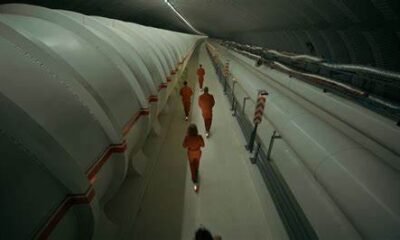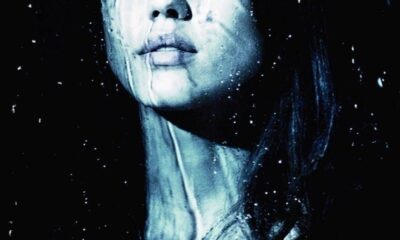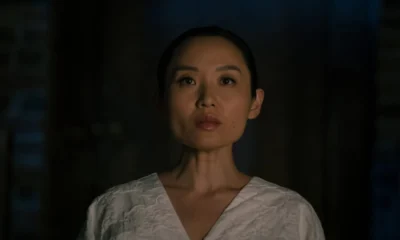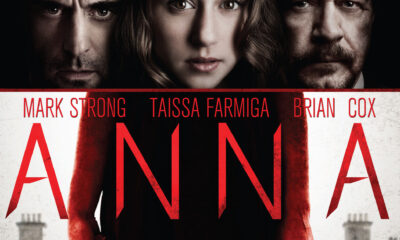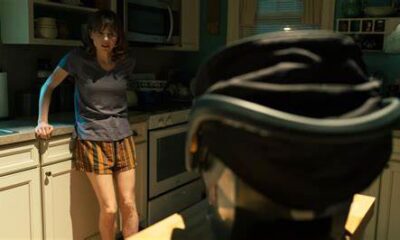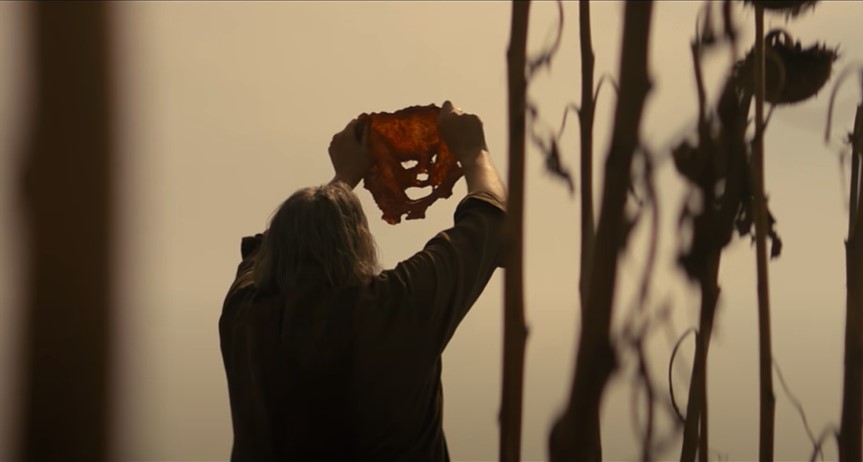
Texas Chainsaw Massacre (2022) Review
Review of the 2022 Texas Chainsaw Massacre film streaming on Netflix. A brief overview of my opinions regarding the remake/sequel’s pros and cons.
Texas Chainsaw Massacre is now available to stream on Netflix
When media outlets began reporting ‘The Texas Chainsaw Massacre‘ would yet again be receiving the “requel” treatment for 2022, I felt less than enthused. Admittedly, my expectations were low; given the previous poor attempts at rebooting the franchise with 2013’s ‘Texas Chainsaw 3D‘ and 2017’s prequel ‘Leatherface‘. However, with the announcement of Fede Alvarez (director of Don’t Breathe and Crawl) as the producer, David Blue Garcia (Blood Fest) as the film’s director, and the long-awaited return of fan favorite final girl Sally Hardesty (played this time by Olwen Fouéré), my interest peaked. I’ll admit upon my first viewing, I enjoyed 2022’s ‘Texas Chainsaw Massacre‘, enough to recently warrant a second watch. Sadly, to my dismay, the chainsaw isn’t nearly as revving this second outing.
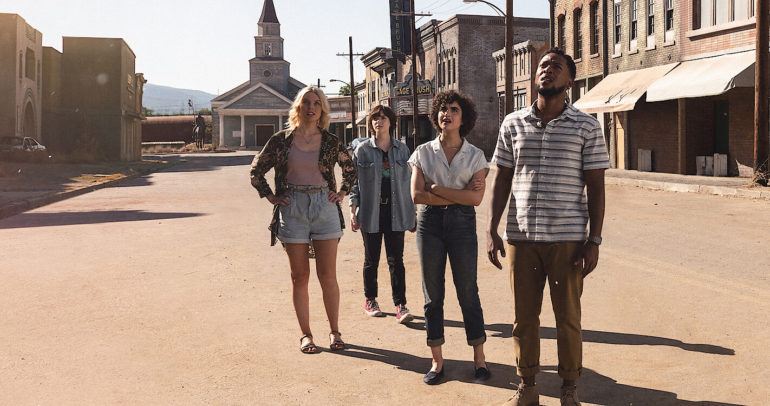
Texas Chainsaw Massacre’s plot centers around Melody (Sarah Yarkin) a young businesswoman from San Francisco, as she and her friends Dante (Jacob Latimore) and Ruth (Nell Hudson) meet potential investors in attempt to reinvigorate the seemingly abandoned town of Harlow, TX and draw in modern influencers. Along the way, Melody brings her younger sister Lila (Elsie Fisher) hoping she will stay in Texas after Lila’s recent traumatic experience involving a school shooting. Unbeknownst to these characters, this isn’t quite the ghost town they think it is, as a certain face-wearing maniac has made this his home these last 48 years. Shortly following the death of his motherly patron, Leatherface (Mark Burnham) resurfaces in merciless fashion to dust off the family saw and butcher more bodies.
Where it still cuts
2022’s Texas Chainsaw Massacre is one of the more visually pleasing entries to the franchise. Garcia’s confidence as a director shines through as he allows for his own vision, while honoring familiarity of past installments. The cinematography masterfully utilizes shadows and lighting, accompanied by meticulous camera angles adding tones of seclusion tangled in chaos. There’s one shot in particular I’m surprised I missed during my first viewing in which we see the physical manifestation of Leatherface through actor Burnhams’ eyes. It’s subtle yet framed so effectively it left me feeling harrowingly chilled.

Now, this wouldn’t be a Texas Chainsaw film without the multiple bodily mutilations splattered on screen and this entry to the franchise is no exception. The kills in this film are savage, if not more creative than its’ predecessors. Writer Chris Thomas Devlin is unabashed by the violence he brings with his script as he is able to write these kills in a way, though may not all be new, feel wholly unique in their execution. For example, in a scene, Leatherface shreds through a bus of influencers in one of the films’ more memorable moments. The deaths are further showcased by this newly found rage brought to Leatherface, adding a ravening brutality to the character we’ve not seen since the ’03 remake. Though the carnage candy Leatherface delivers is enjoyable, my headaches with Texas Chainsaw Massacre start with his character.
Where the saw dulls…
Let me start by saying Burnham’s portrayal of Leatherface in Texas Chainsaw Massacre is far from bad. In fact, his performance is rather good. He’s domineering whenever on screen and visually, he looks fantastic. My issue with this Leatherface lies within the writing. Burnhams’ Leatherface is not the same character the legendary late Gunnar Hanson famously brought to life in 1974. 48 years prior we are introduced to a man with a child-like mind and instinctual violence bred into him due to years of abuse and torment by his twisted family. 2022’s portrayal removes the family, putting Leatherface front and center while also altering him into a more cunning character; he’s setting traps and utilizing enclosed surroundings to his advantage. The most noticeable difference between his 74’ counterpart is the upgrade in his strength. Whereas before, injuries slowed him down bringing whimpers and cries of pain, he now absorbs this damage, baring inhuman strength. There’s no cohesion between Hanson’s Leatherface and Burnhams.
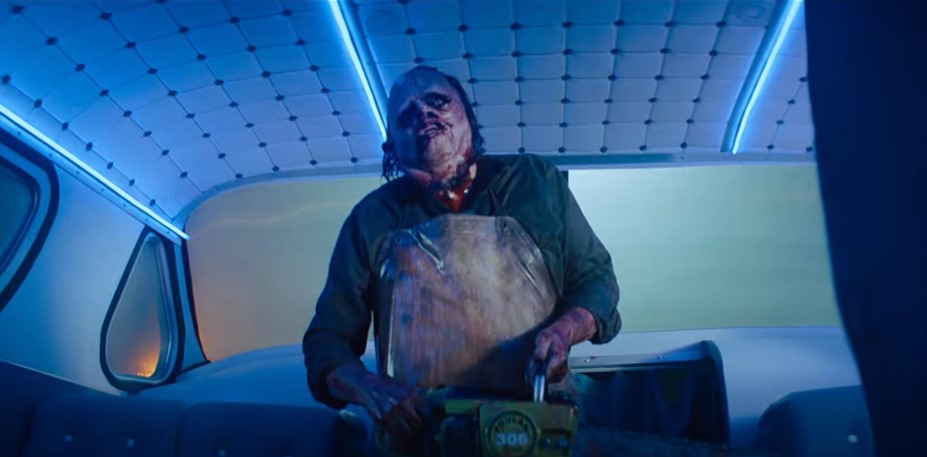
The next frustration I had with the film’s script involved the actual characters we follow throughout the story. In order for a horror film to draw in its’ audience, especially when it comes to slashers, it’s imperative the story provides characters to emotionally invest in. Characters we want to see survive. Unfortunately, the script lacks here as I found none of the characters to be enjoyable. Adding to this annoyance, the plot continuously bounces between who the final girl will be, Melody or Lila? The problem is, I was not provided with enough of their backstories to warrant any care for their survival. Any emotional attachment I could have developed for these characters is never explored, only vague mentions. When the story briefly touches on themes of gun violence (Lila’s school shooting) and society’s most recent trend with cancel culture, it’s done so with no sustenance then sloppily contradicts itself in the 3rd act. Dante, Ruth, and the remaining others feel like cannon fodder, just as you would expect with any Texas Chainsaw Massacre film, as their screen time is brief.
Texas Chainsaw Massacre’s biggest failure is in the way it reintroduces legacy character Sally Hardesty. Besides 1995’s Texas Chainsaw Massacre: The Next Generation‘s brief cameo (reprised by original late actress Marilyn Burns), her character has been mainly absent from past sequels and reboots. Aiming to please fans with her return in the form of a seasoned warrior seeking vengeance à la Jamie Lee Curtis’ most recent portrayal of Laurie Strode in 2018’s Halloween trilogy; a promising premise that’s poorly executed. Aside from owning a farm and unsuccessfully hunting Leatherface these past 48 years, Devlin adds nothing to further progress Sally’s story, nor does the character receive ample screentime. She makes certain decisions that, I’ll be frank, utterly baffles me. Most infuriating is the final battle between Sally and Leatherface. Lasting a mere few minutes, the sequence falls flat leaving fans unsatisfied. Fouéré attempts her best portraying a hardened Sally, though in the end the performance suffers due to the scripts deplorable handling of the character.
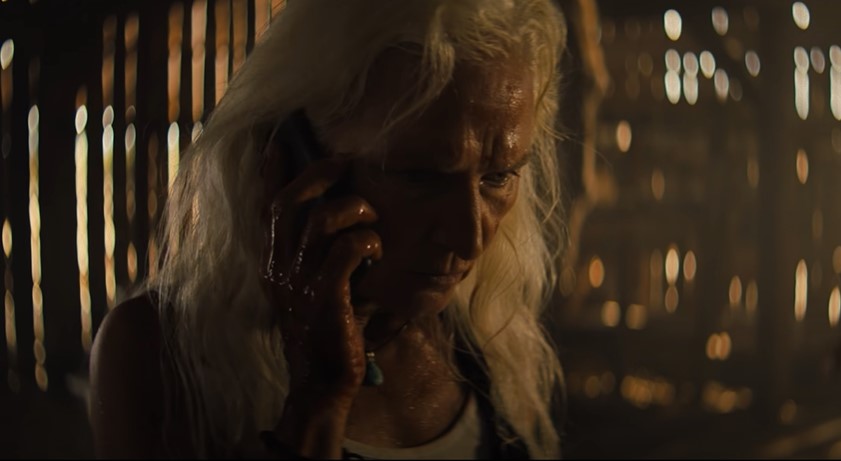
Final Thoughts
Texas Chainsaw Massacre isn’t the worst attempt at a sequel or reboot of the franchise. The abandoned town of Harlow brings a sense of claustrophobia and the extreme use of gore brought to the kills is satisfying. Nevertheless, the writing fails to redefine the Texas Chainsaw Massacre’s legacy and move the franchise forward in any bold new directions. The main and supporting characters suffer from lack of any development and Sally’s return is abysmal. When you centralize Leatherface as the main antagonist and take away his family, we are left with just another carbon copy slasher. Any mystique or personality you had previously established with that character fades; it doesn’t work as a sequel to the original. Those seeking a bloody hack and slash ride will enjoy this film for what it is. Die-hard fans on the other hand, may ultimately walk away feeling disappointed with the wasted potential to start anew.
For more Texas Chainsaw Massacre content, check out our episode of HauntedMTL’s: Streamin’ Demons, where we discuss Tobe Hoopers’ 1974 original The Texas Chainsaw Massacre along with IT, and Ghostbusters: Afterlife. You can also stream or download the episode and many others on your favorite podcast streaming service such as Apple Podcasts, Spotify, Amazon, and more.
 (2.5 / 5)
(2.5 / 5)
Movies n TV
Wheel of Time A Question of Crimson Is a Political Espionage Delight
Episode two of Wheel of Time felt like the beginning of a long journey. Stories are unfolding, lives are changing, and blood is spilling.
Let’s discuss.
The story
We begin this episode in the past with Elayne’s mother, Queen Morgase. It turns out her rise to the throne was a bit, shall we say, cutthroat. So when she shows up at the White Tower, Siuan is concerned.
She might have reason to be, too.
Meanwhile, Rand, Egwene, Moiraine, Lan and Aviendha are in the Spine of The World. As they travel through some of the most breathtaking lands I have ever seen on a TV show, Egwene is plagued with nightmares. We think at first that’s just her trauma working itself through her system. But we soon find out that it might not be that straightforward.
Finally, Perrin returns home to heal after his hand is almost cut in half. But when he gets there he finds the town has been infested by Children of The Light. And they’re looking for him.
What worked
There was something heartwarming in this episode about political espionage and choking religious persecution. And that is Elayne’s relationship with her family.
I have consumed a lot of fantasy content with royal families. And I have never once heard a princess call her mother ‘Mum’. I’ve never seen royal siblings get along. And I have sure as hell never seen a princess have a good relationship with her step-parent.
This was refreshing. Even though Queen Morgase is kind of a horrible person she seems like a good mother. And that’s an unexpected delight.

Of course, this is just one storyline among many. And while this can sometimes be overwhelming, in this case it wasn’t.
I’ll be honest, some of these storylines are going to drag for me. I know this because I’ve read some of the Wheel of Time books and I have an idea that not all the characters exactly pique my interest.
No one likes all the characters. No one likes all the storylines. While I am here for the political espionage between Queen Morgase and Siuan, not everyone likes it. While others might be fascinated with Selene trying to win Rand back, I couldn’t care less.
Having multiple storylines keeps everyone’s attention better. So long as things don’t get out of hand. Things can easily get out of hand. But this seems to be managed well.
So far.
What didn’t work
As I mentioned above, I’m not thrilled with Rand’s story at this point. And while it’s fine to not like a storyline when there are this many to choose from, it’s not fantastic that the one I like the least is the one involving our two main characters. And anytime we were with the team at the Spine of The World, the only thing that brought me joy was Moirain’s hat. It reminded me of Stockard Channing’s hat in Practical Magic.
The problem is that Rand is Charlie Brown with controversial magical powers. He is boring, serious, and pessimistic.
And yes, I understand that he has a heavy emotional burden and he’s the Dragon Reborn and that’s quite taxing and all. But let’s be fair, there isn’t a single person in this show that doesn’t have a heavy burden. And most of them manage to be fun occasionally.

All that being said, this episode of Wheel of Time did exactly what it needed to do. It set up conflicts at each of the three locations. It established emotional ties between the characters and the events. And it established goals for everyone.
This was, in short, a solid episode. Not groundbreaking, not mind-blowing or life changing. It was simply good. It was entertaining and moved the plot forward.
Well done.
 (3.5 / 5)
(3.5 / 5)
Movies n TV
Wheel of Time Returns With A Bang
Wheel of Time is back for season three. There are mixed feelings regarding this. Last season, there were some serious pacing issues. And some serious sticking to the book’s storyline issues. But we’re two seasons in, and we don’t give up so easily. So let’s dive into episode one, To Race the Shadow.
By the way, I highly recommend watching this episode with the subtitles on. You’ll see why.
The story
We begin this episode with Liandrin facing a trial of sorts for her rampant betrayal. She does her best to gaslight her Aes Sedai sisters into thinking that Siuan Sanche is the real traitor.

When that doesn’t work, she reveals how many Black Aes Sedai have actually infiltrated the tower.
Spoiler, it’s a lot.
In the aftermath, our whole team gathers to drink and enjoy one night of relaxation before they head out to the Tear to form an army for Rand. All is going well until they’re attacked by myriad creatures and a sentient axe.
What worked
This episode was long. It had a run time of an hour and eleven minutes. And a lot of that run time was spent in heavy dialog scenes.
Fortunately, these were well-done scenes.
If you’re going to have a lot of talking scenes, there are good ways and bad ways to do it. Last season, we saw lots of examples of the bad way to do it. But this episode did it well. For one thing, other things were going on while conversations were taking place. The characters are drinking, playing games, walking through an interesting city. And the scenes themselves didn’t stretch out. They weren’t repetitive. We heard what the character had to say, then we moved on.
It was also nice that the point of these scenes wasn’t just info dumps. We had character development. We had romantic interactions. We had plot development and foreshadowing.
Overall, this episode felt like what it was. A moment of calm before a storm.
Taking a step back, I’d be remiss if I didn’t address the fight scene at the start of the episode. Because it was epic.
The magic looked amazing. The martial arts that went along with it looked fantastic. The costumes were beautiful. It was just incredibly fun to watch.
More than that, it was emotional. We lost some characters in that fight that were important. And it was clearly emotionally shattering for many of our characters, who found themselves betrayed by people they trusted.
So many of them.
It was a great way to open the season.
What didn’t work
Despite that, this episode wasn’t without its flaws.
First off, there were a lot of dialog scenes. And they were good scenes, as I’ve already discussed. But it was one after another after another. And when your episode is, again, an hour and eleven minutes, it’s maybe a little much to have so much chit-chat. Couldn’t some of these conversations, important as they were, have been moved to maybe another episode?
Finally, I want to talk about Egwene’s travel through the arches.

I feel like maybe there were some deleted scenes here. Because there must have been more to that visit than what we saw, right?
We could have seen Egwene battle Rand. That would have been badass and emotionally devastating. We could have seen her with a quiet life with Rand back home at the Two Rivers. We could have seen anything except for the quick clip of Rand in a bloody river, followed by Egwene being shoved back out in a bloody shift.
Bad job. But at least it wasn’t an extended scene of Moiraine collecting bathwater, and then taking a bath while looking sad. If we’d started this season with another scene like that, it might have broken my brain.
Amazon dropped the first three episodes at once. So we’ll be back soon to talk about episode two. See you then.
 (4 / 5)
(4 / 5)
Movies n TV
Entertaining as hell: Eight Legged Freaks (2002) Review
Early 2000s is a special era for the industry. It accepts the cheesiness and corniness of movie making, in turn producing some gems in their own right. Eight Legged Freaks starring David Arquette and young Scarlet Johanson is a horror comedy about giant spiders who overtake a small town. As crazy as that premise sounds, the movie surprisingly has a ton of heart and is super entertaining. Let’s review, shall we?
Plot
We start Eight Legged Freaks with a shot of toxic waste spilling into the water supply of Joshua, a spider farm owner. He is friends with Mike, one of our protagonists, who is a science geek and a spider enthusiast. Mike notices something quite right upon visiting Joshua, but no one takes him seriously. We are then introduced to the rest of the crew. Mike’s mother Samantha, the town sheriff, is too busy chasing Ashley, his sister, who is dating the town mayor’s son Bret (something Samantha does not approve of). We also have Chris, who returns to the town to save his father’s legacy in the town mines. He has opposition from Wade, Bret’s father, who wants to use the mines for his business ventures. Lots of drama going on that will only get juicier once the spiders get loose.
The creepy crawlies quickly dispose of Joshua and make their grand appearance after Ashley rejects Bret’s advances, abandoning him in the middle of a desert. A glorious chase sequence ensues as the spiders make their way towards the town, wreaking havoc on its residents. In a true horror fashion (which the movie acknowledges), it takes some convincing from Mike and then from Samantha for the town to take the threat seriously. The tongue-in-cheek style of narrative adds the comedy aspect to a movie that would otherwise burn out fairly quickly.
The remaining characters hide out in a shopping mall as it’s the only somewhat sturdy building in the area. This doesn’t last long as the spiders break in, forcing them to run through the mines. Their resources to fight the creepy crawlies off are limited as the methane gas doesn’t allow them to use firearms. Such conditions require resourceful thinking from Chris, who uses perfume to fend off the leader of the spider group and save himself during the climax of the movie.
Character dynamics are not forgotten once the action kicks in. We have Chris confessing his long-term feelings for Samantha which she knew all along, which provided some comedic relief. Bret also reunites with Ashley and apologises for being an asshole. Mike finally gets the appreciation he deserves as his knowledge saves the townsfolk more than once during the whole ordeal.
We end the movie with the town’s radio show person telling the story as an urban legend during his segment. This brings it into question – how much of it happened the way he said it did? We can only guess…
Overall thoughts
Eight Legged Freaks is a fun creature feature with some self-aware commentary on genre tropes that doesn’t take itself too seriously. The acting is good, the pacing fitting and the characters are likeable enough for you to want them to make it through. Definitely a must watch, if you don’t suffer from arachnophobia, that is.
 (5 / 5)
(5 / 5)


